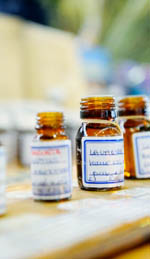 Whether you are just now embarking upon the incredible journey of learning about and using essential oils, or have been working with these valuable medicines for some time, you will soon find that selecting the best possible essential oil supplier makes all the difference in your experience. The truth is, not all essential oils are created equal. And, with the demand and market for these wonderful gifts of nature growing exponentially and rapidly, it is becoming more and more difficult to determine which essential oils are truly high quality, and which are cheap knock offs of the real thing.
Whether you are just now embarking upon the incredible journey of learning about and using essential oils, or have been working with these valuable medicines for some time, you will soon find that selecting the best possible essential oil supplier makes all the difference in your experience. The truth is, not all essential oils are created equal. And, with the demand and market for these wonderful gifts of nature growing exponentially and rapidly, it is becoming more and more difficult to determine which essential oils are truly high quality, and which are cheap knock offs of the real thing.
There are several aspects that you want to consider when selecting an essential oil supplier. First of all, it is important to understand that there is no regulation on essential oil production in the U.S. or elsewhere. Therefore, it is the buyer’s responsibility to ensure that she is purchasing essential oils from a trusted source. Look for an essential oil supplier with a web page that demonstrates real knowledge about the products being sold – the more information, the better.
Make sure that the essential oils you are considering purchasing are not adulterated with synthetic chemicals or filler oils. Many essential oils are mixed with less expensive essential oils or cheap vegetable oils. There is no law to stop an essential oil supplier from mixing an essential oil with 90% vegetable oil, and they can still sell the oil as “pure, natural, and organic”. Be sure to do your research and spend some time exploring the webpages of different suppliers. If a supplier is not diluting the essential oils, they will almost certainly say so with pride.
If you would like to be sure that your supplier is not adulterating products, ensure that they provide purity testing for EACH BATCH of essential oils, and that they make GCMS (Gas Chromatography – Mass Spectrometry), Certificates of Analysis, and MSDS (Material Safety Data Sheets) available to all customers. In particular, the GCMS and Certificates of Analysis will let you verify that you are purchasing an essential oil that is pure and unadulterated.
If you come across a supplier that advertises products as “organic”, this is a good sign, but when it comes to essential oils, organics are only one part of the issue. As you may know, USDA Organic status is quite an expensive little label for any company to pay for, and many of the big essential oil companies that label oils as Certified Organic are actually making significant profits selling these oils to the flavor and food products industry. In the United States, for an essential oil to be labelled Food Grade and safe for internal ingestion, it must be distilled twice. Thus, any company that is selling essential oils and listing them as safe for internal consumption is re-distilling oil. Essential oils that are distilled for internal consumption are also often prepared under higher than normal pressure. Both of these factors create an essential oil that is less vibrant and significantly more processed than essential oils that are produced under normal pressure. Therefore, a USDA Organic essential oil may actually be less vibrant and beneficial for health than a small-batch artisan essential oil.
We highly recommend selecting an essential oil supplier who works with smaller, independent micro-distilleries who produce small batches of high-quality, minimally processed essential oils. These oils contain the most potent essence of the plant possible, and will have the most potent health benefits. Many companies that cannot afford USDA Organic certification will still proudly state that they do not use plant matter treated with synthetic fertilizers and chemicals, and if you feel you can trust such a company, such a statement may be sufficient.
Essential Oil Exchange is a unique essential oil supplier that is working to provide access to affordable, high-quality essential oils as well as to create a well-informed community of individuals passionate about these marvelous medicines. We are always working to bring you accurate information about the many uses of essential oils, and strive to ensure the quality of each batch of essential oils that we provide by working with small, artisan distillers from all over the world. Furthermore, for $10 a month, you can become a member of our cooperative and receive 50% off of every purchase – true wholesale prices – for as long as you remain a member. We hope that the benefits of our model of business are clear, and that you consider us seriously in your search for reliable, high-quality essential oils!


 The aborigines of Australia were the first humans to discover the healing qualities of the eucalyptus tree, but the koala, Australia’s lovable herbivorous marsupial, was actually the first mammal to discover the amazing leaves of the eucalyptus. A koala spends at least three of its five active hours eating the leaves of several varieties of eucalyptus trees because they are low in protein and high in phenolic compounds, which are powerful antioxidants [1]. Eucalyptus leaves are also rich in terpene compounds, which are the primary constituents in the essential oil of the eucalyptus tree. The aborigines undoubtedly noticed the affect of eucalyptus on the koala, and began to use the leaves in order to benefit healthwise. They used these species for antiseptic, repellent, and flavoring purposes.
The aborigines of Australia were the first humans to discover the healing qualities of the eucalyptus tree, but the koala, Australia’s lovable herbivorous marsupial, was actually the first mammal to discover the amazing leaves of the eucalyptus. A koala spends at least three of its five active hours eating the leaves of several varieties of eucalyptus trees because they are low in protein and high in phenolic compounds, which are powerful antioxidants [1]. Eucalyptus leaves are also rich in terpene compounds, which are the primary constituents in the essential oil of the eucalyptus tree. The aborigines undoubtedly noticed the affect of eucalyptus on the koala, and began to use the leaves in order to benefit healthwise. They used these species for antiseptic, repellent, and flavoring purposes.